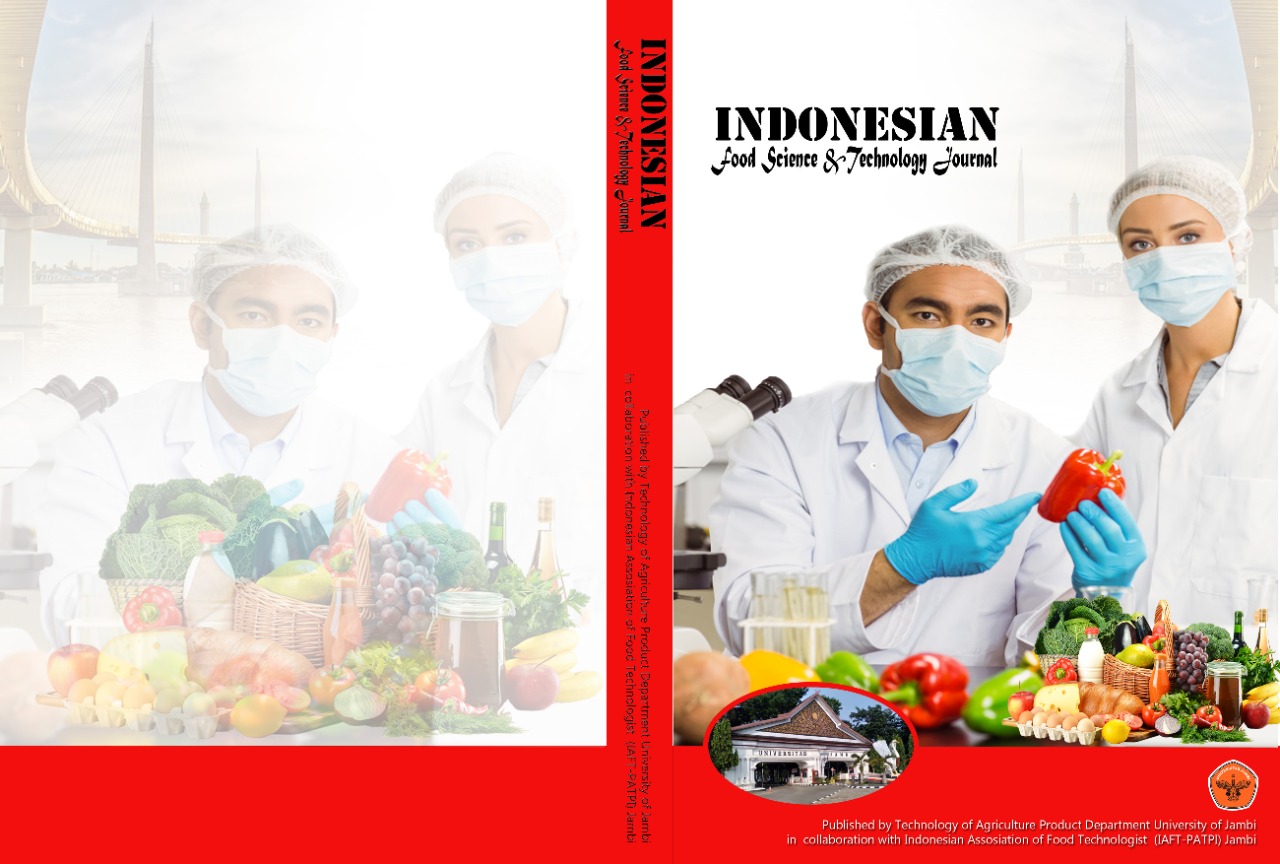Hydrolysis With Two Enzymes in Edible Fern (Diplazium esculentum) as a Source of Flavours
DOI:
https://doi.org/10.22437/ifstj.v7i2.30960Keywords:
Bromelain enzyme; flavours; glutamic acid; protease (papain)Abstract
Ferns (Diplazium esculentum) had high content of proteins, fats, flavonoids, and polyphenols, especially in young fern leaves. Its potential to developed as a source vegetable flavour. Currently, understanding about fern flavor processing technologies and the potential of ferns for health is still relatively limited, especially on local Indonesian fern. This research aims to know about morphological characteristics of Indonesian local fern vegetables (Mloko Jember, Air Jember, and Ayam Banyuwangi), and determined the effect of processing to its chemical characteristics and volatile compound, then hydrolyzed enzymes to produce non-volatile flavours. Ferns are processed by steaming, drying, and control methods and are hydrolyzed by combining two enzymes - bromelain and protease, with a pH of 7 and temperature of 55 0C for 1 hour. The result showed that the morphology of the three fern are different in the shape of shoot and plant based on their location. The researchers discovered that enzymatically hydrolyzing the proteins in local fern vegetables using two enzymes (bromelain and protease) produced amino acid components such as aspartic acid and glutamic acid. These have MSG-like flavour.
Downloads
References
B, Sareen, A, Bhattacharya, V, Srivatsan. Nutritional characterization and chemical composition of Diplazium maximum (D. Don) C. Chr., Bhuvnesh. J Food Sci Technol. 2020, 58: 844-854. DOI: 10.1007/s13197-020-04598-w
O.R. Fennema, ”Food Chemistry Third Edition”, Edited By University Of Wisconsin-Madison Madison, Wisconsin Marcel Dekker, Inc, New York, Basel, Hong Kong, 1996
FA, Karim, F, Swastawati, AD. Anggo. The effect of different raw material to glutamic acid content in fish paste. Jurnal Pengolahan dan Bioteknologi Hasil Perikanan 2014, 3(4): 51–58. [In Indonesian]
D, Baines and M, Brown. Flavours enhancers: characteristics and uses. Encyclopedia of Food and Health 2016: 716-723. https://doi.org/10.1016 /B978-0-12-384947-2.00297-X
HR, Fauzy, T, Surti, Romadhon. The effect of granulator drying method to glutamic acid content of fish paste powder from mackerel scad (Decapterus spp.) boiled waste. Jurnal Pengolahan dan Bioteknologi Hasil Perikanan 2016, 5(1): 16-22.
K, Wijayasekara and J, Wansapala. Comparison of a flavours enhancer made with locally available ingredients against commercially available mono sodium glutamate. International Journal of Gastronomy and Food Science 2020, 23(1): 100286. https://doi.org/101016/j.ijgfs. 2020
S, Vanita, A, Sarika, RW, Ingle. Effect of nutritional and physiological factors on growth and sclerotial formation of Rhizoctonia bataticola (Tan b) butler isolates. Journal of Plant Disease Sciences 2009, 4(1): 44-48
G, Freeman and RJ, Wenham. A survey of volatile components of some Allium species in terms of S-alk(en)yl-L-cysteinesulphoxide present as flavours precursors. J. Sci. Food Agric 1975, 26: 1869-1975
T, Tabata, K, Tomioka, Y, Iwasaka, H, Shinohara, T, Ogura. Comparison of chemical compositions of shiitake (Lentinus edodes (Berk.) Sing) cultivated on logs and sawdust substrate. Food Science and Technology Research 2006, 12: 252-255. DOI: 10.3136/fstr.12.252
JK, Fellman, TW, Miller, DS, Mattinson, JP, Mattheis. Factors that influence biosynthesis of volatile flavours compounds in apple fruits. Hort. Science 2000, 35(6): 1026-1033. https://doi.org/10.21273 /HORTSCI. 35.6.1026
AB, Elizabeth, WS, John, K, Christine, Shewmaker, S, Wolfgang. Flavours trivia and tomato aroma: Biochemistry and possible mechanisms for control of important aroma components. Hort. Science 2000, 35(6):1013-1022.https://doi.org/10.21273/hortsci.35.6. 1013
J, Cebolla-Cornejo, SM, Roselló, E, Serrano, J, Beltrán, F, Nuez. Evaluation of genotype and environment effects on taste and aroma flavours components of Spanish fresh tomato varieties. J. Agric. Food Chem. 2011, 59(6): 2440-50. DOI: 10.1021/jf1045427
M, Porter, Z, Fan, S, Lee, M, Vance, Whitaker. Strawberry breeding for improved flavours. Crop Science 2023, 63: 1949-1963. https://doi.org/10.1002/csc2.21012
P, Banjongsinsiri, K, Pasakawee, U, Rodsuwan. Production of mushroom protein hydrolysates by enzymatic hydrolysis and their physicochemical properties. Food and Applied Bioscience Journal 2016, 4(3): 161-170. DOI: 10.14456/FA BJ. 2016.15
A, San-San , M, Rashedi, Ismail-Fitry. Production of different mushroom protein hydrolysates as potentialflavoursings in chicken soup using stem bromelain hydrolysis. Food Technol Biotechnol 2019, 57(4): 472-480. DOI: 10.17 113/ftb.57.04.19.6294
G, Yi-Fang, Wu , KR, Cadwallader. Characterization of the aroma of a meat like process flavoursing from soybean-based enzyme-hydrolyzed vegetable protein. J. Agric. Food Chem. 2002, 50(10): 2900-7. DOI: 10.1021/jf0114076
I, Normah and M, Noorasma. Flavours improvement of mud clam (Polymesoda erosa) hydrolysate by using Maillard reaction. International Food Research Journal 2018, 25(3): 1146-1152.
KN, Wijayasekara and J, Wansapala. Comparison of a flavours enhancer made with locally available ingredients against commercially available mono sodium glutamate. Journal pre-proof.PII 2020, 20: S1878-450X DOI: https://doi.org/10.1016/j.ijgfs.2020.10 0286, 2020
SNI 01-2891-1992. “Cara Uji Makanan dan Minuman”. BSN, 1992. (http://sispk.bsn.go.id/SNI/DetailSNI/3258) [In Indonesian].
VL, Singleton, R, Orthofer, RM, Lamuela-Raventos. Analysis of total phenols and other oxidation substrates and antioxidants by means of Folin-Ciocalteu Reagent. Methods in Enzymology 1999, 299: 152-178. http://dx.doi.org/10.1016/S0076-6879(99) 99017-1
K.R. Markham and T.J. Mabry, ”Ultraviolet-visible and Proton Magnetic Resonance Spectroscopy of Flavonoids”. In: J.B. Harborne, T.J. Mabry, H. Mabry, Eds, The flavonoids, Chapman and Hall, London, 1975, 45-77
S. Sudarmaji, B. Haryono, Suhardi, “The procedures for agricultural foodstuffs”, 3rded, Liberty, Yogyakarta 1984 [In Indonesian].
L, Manzocco, S, Calligaris, D, Mastrocola, M, Nicoli, C, Lerici. Review of non enzymatic browning and antioxidant capacity in processed food. Trends Food Science and Technology 2011, 11: 340-346. DOI: 10.1016/S0924-2244(01)00014-0
I, Lesschaeve and AC, Noble. Polyphenols: Factors influencing their sensory properties and their effects on food and beverage preferences 1–3. The American Journal of Clinical Nutrition 2005, 81(1): 330S-335S. https://doi.org/10.1093/ajcn/81.1.330S
M, Kyoung, EB, Moon, Kwon, Bonggi, C, Lee, K, Young. Recent trends in controlling the enzymatic browning of fruit and vegetable products. Molecules 2020, 25(12): 2754. DOI:10.3390/molecules25122754
A, Bernstein, P, Caciano, Zapata, Noreña. Kinetics of enzymatic inactivation and loss of anthocyanins and antioxidant activity in red cabbage blanched under different conditions. Journal of Food Biochemistry 2016, 41(3): 12340. https:// doi.org/ 10. 1111/jfbc.12340
D, Shortle and MS, Ackerman. Persistence of native-like topology in a denatured protein in 8 m urea. Science 2001, 293: 487-489. DOI: 10.1126 /science.1060
NT, De Castro, L, de Lacerda, E, de Alencar, RBA, Botello. Is there a best technique to cook vegetables. A study about physical and sensory aspects to stimulate their consumption. Int. J. Gastron. Food Sci 2020, 21: 100218. https://doi.org/ 10.1016/j.ijgfs.2020.100218
A, Mehmood and A, Zeb. Effects of different cooking techniques on bioactive contents of leafy vegetables. Int. J. Gastron. Food Sci. 2020, 22: 100246 https://doi.org/10.1016 /j.ijgfs.2020.100246
LC, Dos Reis, R, Oliveira, VRD, Hagen, MEK, Jablonski, SH, Flôres, ADO, Rios. Effect of cooking on the concentration of bioactive compounds in broccoli (Brassica oleracea var. avenger) and cauliflower (Brassica oleracea var. alphina f1) grown in an organic system. J. Food Chem. 2014, 172: 770-777. DOI: 10.1016/S0924-2244(01)00014-0
MV, Boekel, V, Fogliano, N, Pellegrini, C, Stanton, G, Scholz, S, Lalljie, V, Somoza, D, Knorr, PR, Jasti, G, Eisenbrand. Review on the beneficial aspects of food processing. Mol. Nutr. Food Res. 2010, 54: 1215-1247. DOI: 10.1002/mnfr.2009006 08
M, Palermo, N, Pellegrini, V, Fogliano. The effect of cooking on the phytochemical content of vegetables. J. Sci. Food Agric. 2013, 94(6): 1057-1070. DOI: 10.1002 /jsfa.6478
NW, Desresie, “The Technology of Food Preservation”, The AVI Publishing Company, Inc, Westport, 1959.
HG, Kristinsson and BA, Rasco. Biochemical and functional properties of Atlantic salmon (Salmo salar) muscle proteins hydrolyzed with various alkaline proteases. J. Agric. Food Chem. 2000, 48(3): 657-66. DOI: 10.1021/jf990447v
AM, Liceaga-Gesualdo and ECY, Li-Chan. Functional properties of fish protein hydrolysate from herring (Clupea harengus). Journal of Food Science 1999, 64(6): 1000-1004. https://doi.org/10.1111/j.1365-2621.1999.tb12268.x
Y, Witono, I, Taruna, WS, Windrati, L, Azkiyah, TN, Sari. Wader (RasboraJacobsoni) protein hydrolysates: Production, functional properties. Agriculture and Agricultural Science Procedia 2016, 9: 482-492. DOI: 10.1016/j.aaspro.2016.02.167
J, Khongdetch, N, Laohakunjit, R, Kaprasob. King boletus mushroom-derived bioactive protein hydrolysate: Characterisation, antioxidant, ACE inhibitory and cytotoxic activities. International Journal of Food Science & Technology 2021, 57: 1399-1410. https:// doi.org/ 10.1111 /ijfs.15100
PA, Temussi. The good taste of peptides. J. Pept. Sci. 2012, 18: 73-82. DOI: 10.1002/psc.1428
F, Amalia. Umami sebagai rasa dasar ke-5. 2010. (http://mediaprofesi.com/gaya-hidup/92-umami-sebagai-rasa-dasar - ke-5-html) [In Indonesian].
T. Yokotsu, “Aroma and flavours japanese soy sauce”, in Mark Em, Chichester Co, Stewart Gf(Eds), Advances In Food Research, IV, New York: Academic Press, 1960.
O, Selamassakul, N, Laohakunjit, O, Kerdchoechue, L, Yang, CS, Maier. Isolation and characterisation of antioxidative peptides from bromelain-hydrolysed brown rice protein by proteomic technique. Process Biochemistry 2018, 70: 179-187. DOI: 10.1016/j.procbio.2018.03.024
M, Dermiki, N, Phanphensophon, DS, Mottram, L, Methven. Contributions of non-volatile and volatile compounds to the umami taste and overall flavours of shiitake mushroom extracts and their application as flavours enhancers in cooked minced meat. Food Chemistry 2013, 141, 77-83. DOI: 10.1016/j.foodchem.2013.03.018
M, Dermiki, R, Mounayar, C, Suwankanit, J, Scott, OB, Kennedy, DS, Mottram, MA, Gosney, H, Blumenthal, L, Methven. Maximising umami taste in meat using natural ingredients: Effects on chemistry, sensory perception and hedonic liking in young and old consumers. J. Sci. Food Agric. 2013, 93: 3312–3321. https:// doi.org/10.1002/jsfa.6177.
Downloads
Published
How to Cite
Issue
Section
License
Copyright (c) 2024 Indonesian Food Science and Technology Journal

This work is licensed under a Creative Commons Attribution 4.0 International License.







